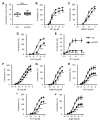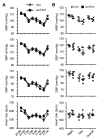IP3 receptors regulate vascular smooth muscle contractility and hypertension
- PMID: 27777977
- PMCID: PMC5070959
- DOI: 10.1172/jci.insight.89402
IP3 receptors regulate vascular smooth muscle contractility and hypertension
Abstract
Inositol 1, 4, 5-trisphosphate receptor-mediated (IP3R-mediated) calcium (Ca2+) release has been proposed to play an important role in regulating vascular smooth muscle cell (VSMC) contraction for decades. However, whether and how IP3R regulates blood pressure in vivo remains unclear. To address these questions, we have generated a smooth muscle-specific IP3R triple-knockout (smTKO) mouse model using a tamoxifen-inducible system. In this study, the role of IP3R-mediated Ca2+ release in adult VSMCs on aortic vascular contractility and blood pressure was assessed following tamoxifen induction. We demonstrated that deletion of IP3Rs significantly reduced aortic contractile responses to vasoconstrictors, including phenylephrine, U46619, serotonin, and endothelin 1. Deletion of IP3Rs also dramatically reduced the phosphorylation of MLC20 and MYPT1 induced by U46619. Furthermore, although the basal blood pressure of smTKO mice remained similar to that of wild-type controls, the increase in systolic blood pressure upon chronic infusion of angiotensin II was significantly attenuated in smTKO mice. Taken together, our results demonstrate an important role for IP3R-mediated Ca2+ release in VSMCs in regulating vascular contractility and hypertension.
Figures





Similar articles
-
MiR-204 regulates type 1 IP3R to control vascular smooth muscle cell contractility and blood pressure.Cell Calcium. 2019 Jun;80:18-24. doi: 10.1016/j.ceca.2019.03.006. Epub 2019 Mar 23. Cell Calcium. 2019. PMID: 30925290 Free PMC article.
-
Inositol 1,4,5-trisphosphate (IP3) receptor up-regulation in hypertension is associated with sensitization of Ca2+ release and vascular smooth muscle contractility.J Biol Chem. 2013 Nov 15;288(46):32941-51. doi: 10.1074/jbc.M113.496802. Epub 2013 Oct 4. J Biol Chem. 2013. PMID: 24097979 Free PMC article.
-
Consequences of postnatal vascular smooth muscle EGFR deletion on acute angiotensin II action.Clin Sci (Lond). 2016 Jan;130(1):19-33. doi: 10.1042/CS20150503. Epub 2015 Oct 5. Clin Sci (Lond). 2016. PMID: 26438881
-
Calcium channels expressed in vascular smooth muscle.Circulation. 1992 Dec;86(6 Suppl):III61-7. Circulation. 1992. PMID: 1330365 Review.
-
[TRIC(trimeric intracellular cation)-A channels contribute to blood pressure maintenance in vascular smooth muscle].Yakugaku Zasshi. 2012;132(9):1037-43. doi: 10.1248/yakushi.132.1037. Yakugaku Zasshi. 2012. PMID: 23023421 Review. Japanese.
Cited by
-
IP3 receptor orchestrates maladaptive vascular responses in heart failure.J Clin Invest. 2022 Feb 15;132(4):e152859. doi: 10.1172/JCI152859. J Clin Invest. 2022. PMID: 35166236 Free PMC article.
-
Calcium Signaling Dynamics in Vascular Cells and Their Dysregulation in Vascular Disease.Biomolecules. 2025 Jun 18;15(6):892. doi: 10.3390/biom15060892. Biomolecules. 2025. PMID: 40563532 Free PMC article. Review.
-
IP3R-mediated Ca2+ signaling controls B cell proliferation through metabolic reprogramming.iScience. 2022 Apr 6;25(5):104209. doi: 10.1016/j.isci.2022.104209. eCollection 2022 May 20. iScience. 2022. PMID: 35494252 Free PMC article.
-
P209L mutation in Bag3 does not cause cardiomyopathy in mice.Am J Physiol Heart Circ Physiol. 2019 Feb 1;316(2):H392-H399. doi: 10.1152/ajpheart.00714.2018. Epub 2018 Nov 30. Am J Physiol Heart Circ Physiol. 2019. PMID: 30499714 Free PMC article.
-
MiR-204 regulates type 1 IP3R to control vascular smooth muscle cell contractility and blood pressure.Cell Calcium. 2019 Jun;80:18-24. doi: 10.1016/j.ceca.2019.03.006. Epub 2019 Mar 23. Cell Calcium. 2019. PMID: 30925290 Free PMC article.
References
-
- Conlin PR, Williams GH. Use of calcium channel blockers in hypertension. Adv Intern Med. 1998;43:533–562. - PubMed
-
- Cummings DM, Amadio P, Nelson L, Fitzgerald JM. The role of calcium channel blockers in the treatment of essential hypertension. Arch Intern Med. 1991;151(2):250–259. - PubMed
-
- De Smedt H, et al. Determination of relative amounts of inositol trisphosphate receptor mRNA isoforms by ratio polymerase chain reaction. J Biol Chem. 1994;269(34):21691–21698. - PubMed
Publication types
MeSH terms
Substances
Grants and funding
LinkOut - more resources
Full Text Sources
Other Literature Sources
Medical
Molecular Biology Databases
Miscellaneous

